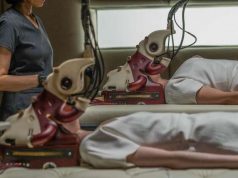We begin with an understatement: “The men who enter our building are not so good.” These are the words of a prostitute’s daughter who lives with her mother in a Calcutta whorehouse, spoken at the beginning of “Born into Brothels.” There are other children there, too, also the offspring of working women. It seems likely that if they are not rescued, they will grow up to be prostitutes as well.
That is the alarming premise of Zana Briski and Ross Kauffman’s documentary, but the film doesn’t quite do it justice. Not that we need to see ALL the sordid details of their mothers’ lives, but more emphasis on the facts that a) this is a brothel and b) the children are on track to become employees there themselves would have been useful. The squalor and filth that are shown could be any slum or ghetto — upsetting, of course, to have children stuck there, but not nearly as much as when you know it’s a whorehouse.
Nonetheless, even as a documentary about poor children, “Born into Brothels” is mostly an effective one. It follows Briski, a photographer who comes to the red-light district to teach her craft to the children, as she attempts to raise money to get the kids out of there. She is struck by how happy the children are despite their surroundings, how they find pleasure in simple things like flying kites from the brothel’s roof. And she is appalled by their mothers’ grotesque behavior, their cattiness toward one another, their wanton desperation. Briski is compelled to help — and, of course, to film herself helping.
The children, of whom seven are featured, are endearing, and have a variety of attitudes toward Briski and her labors. One boy, Avijit, displays a remarkable proficiency at photography and is accepted into a special young artists’ exhibition in Amsterdam — if he can get a passport. Briski tries to get the children enrolled in a private school — but even if she succeeds, their parents must approve, and many of them don’t like interlopers.
Briski and Kauffman serve as directors, producers and editors (with Nancy Baker, somewhat more experienced, helping on the latter chore), despite never having done anything like this before. Their novice status shows a little in the tangents the film takes, and in its failure to fully explore the facets with the most potential for drama. But if the film itself is not stellar, the humanitarian efforts it documents are. In this case, the content is more noble than the way it’s presented.
B- (1 hr., 22 min.; )





